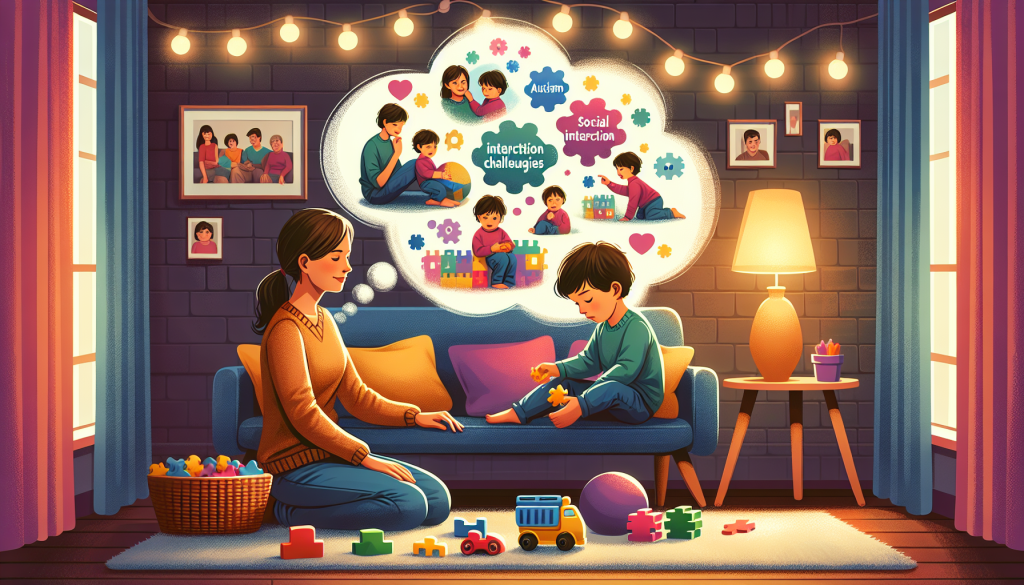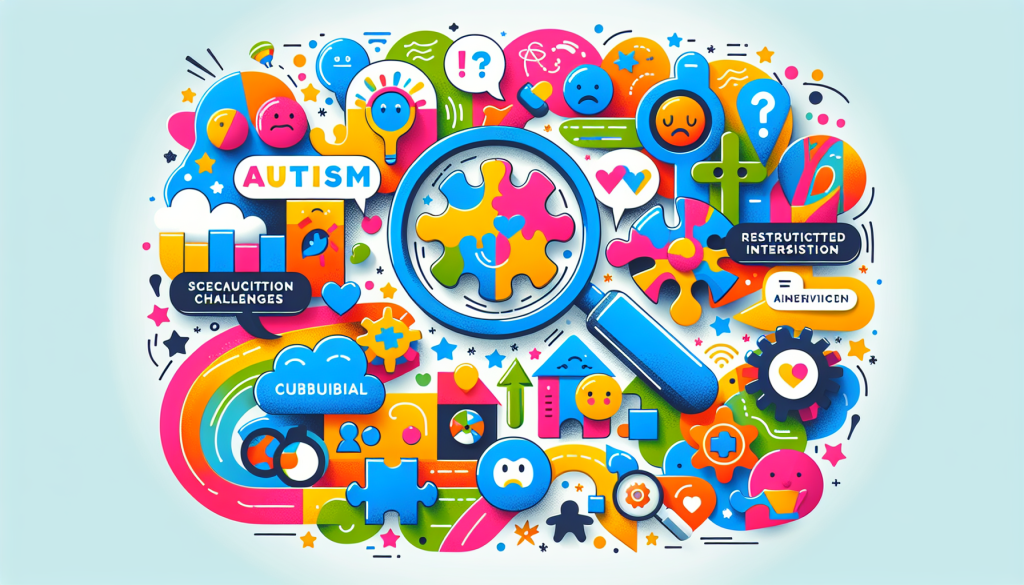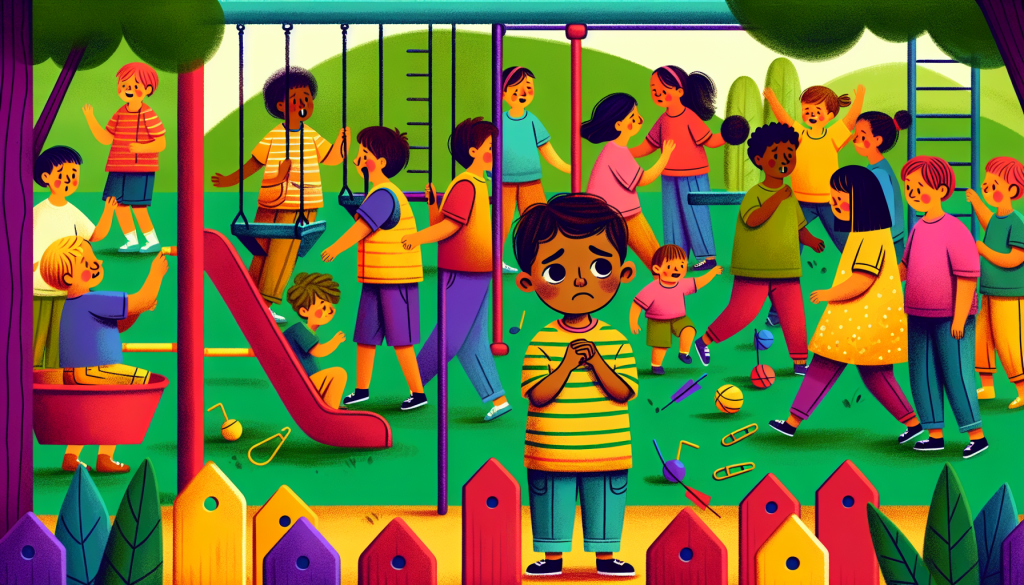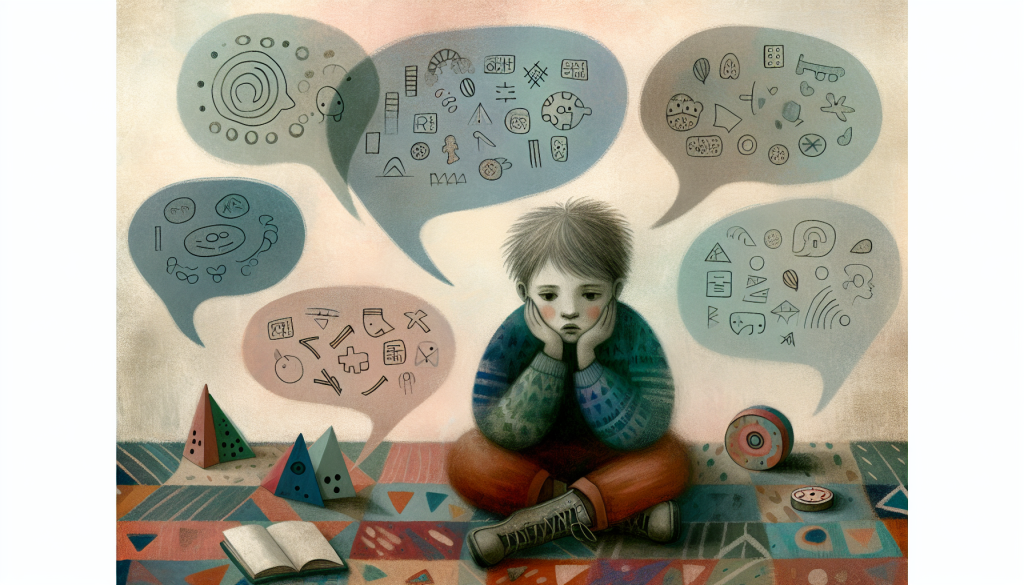What are the main autism characteristics in 4 year olds? Spotting early signs in social interaction, communication, and behavior is essential for timely intervention. This guide will help parents identify these traits and seek the right support.
Key Takeaways
- Autism Spectrum Disorder (ASD) affects social interaction, communication, and behavior in children, with early identification playing a crucial role in improving developmental outcomes.
- Key characteristics to observe in 4-year-olds for signs of autism include challenges in social interactions, communication difficulties, and the presence of repetitive behaviors.
- Parents are essential in recognizing signs of autism and should proactively seek professional evaluations to access necessary interventions and support for their child’s development.
Recognizing Autism Characteristics in 4 Year Olds: A Guide for Parents

Autism spectrum disorder (ASD) affects around 1 in 54 children, influencing how they learn, think, and interact with the world. The three key areas to observe for signs of autism in 4-year-olds include social interaction challenges, communication difficulties, and repetitive behaviors. Early recognition of these signs can pave the way for accessing essential support and resources, greatly enhancing a child’s developmental outlook.
High functioning autism may present differently, but common characteristics include difficulties in social interactions, challenges in communication, and the presence of repetitive behaviors. Identifying these traits can guide parents in seeking an autism diagnosis and pursuing early intervention.
Introduction
Children with autism may require varying levels of support depending on their individual needs. Every child on the autism spectrum is unique, each with their own strengths and challenges. Many children with high functioning autism can lead fulfilling lives. This is possible with the right support and interventions.
Love and acceptance help children with autism thrive and reach their full potential. Understanding and addressing specific needs allows parents to create a supportive environment that fosters growth and development.
This guide provides practical advice and resources to help parents navigate this journey.
Understanding Autism Spectrum Disorder (ASD)

Autism spectrum disorder (ASD) is a developmental disorder that affects social interaction, communication, and behavior. It impacts each individual differently, with some children exhibiting only mild symptoms while others may have more severe challenges. This variability is why it’s referred to as a spectrum disorder.
Early identification of autism is crucial for improving developmental outcomes and accessing appropriate resources. Identifying signs of autism early enables timely intervention, significantly enhancing adaptive functioning and overall outlook. Parents play a crucial role by observing their child’s behavior and seeking professional evaluations when needed.
Defining Autism Spectrum Disorder
Autism Spectrum Disorder (ASD) is characterized by significant challenges in social interactions, communication skills, and the presence of restricted or repetitive behaviors. These characteristics can vary widely in severity, meaning that no two individuals with autism are exactly alike. Some children may need substantial support, while others with high functioning autism might require less assistance but still face unique challenges.
Children with autism experience and learn about the world in ways that differ significantly from their peers. They often possess unique strengths, such as attention to detail or exceptional memory, which can be harnessed with the right support. Recognizing these differences is crucial for providing the appropriate interventions and resources.
Importance of Early Identification
Early identification of autism can vastly improve a child’s developmental outlook. Timely recognition of autism signs leads to early intervention, improving outcomes in communication, social skills, and adaptive behaviors. This early support helps autistic children navigate their environment more effectively and reduces long-term challenges.
Parents are vital in recognizing early signs of autism and initiating the evaluation process. Vigilance and proactivity ensure children receive necessary interventions promptly, improving their overall development and well-being.
Social Interaction Challenges in 4-Year-Olds with Autism

Children with autism often face significant challenges in social interactions, which can include difficulty with eye contact, understanding social cues, and engaging in reciprocal conversations. These difficulties can lead to social isolation and make it challenging for them to form relationships with peers.
Understanding these challenges is the first step towards providing the support they need to improve their social skills.
Difficulty with Eye Contact
A common challenge for autistic children is difficulty with eye contact. Limited eye contact often affects social interactions and engagement with peers, creating barriers to forming relationships. This can result in misunderstandings and missed social cues, further complicating their ability to connect with others.
Early support and interventions help improve the social and communication skills of children with autism. Seeking professional help can assist children in overcoming these challenges and improving social interaction.
Struggles with Social Cues
Autistic children may find it hard to recognize and interpret social signals such as facial expressions and tone of voice. This difficulty in interpreting body language and facial expressions can lead to misunderstandings during social interactions. Understanding these social cues is crucial for forming and maintaining peer relationships.
These challenges can significantly impact an autistic child’s ability to forge friendships and engage with peers. Support and guidance in interpreting these cues can improve social interactions and relationships.
Limited Interest in Peer Play
Children with autism might prefer solitary activities over engaging in play with peers, impacting their social development. This preference for solitary play can lead to challenges in developing social skills and forming relationships with peers. Interactive play and social opportunities can help mitigate these challenges.
Structured play activities and guided interactions aid in practicing and improving social skills in autistic children. By creating a supportive environment, parents can assist their children in developing the necessary skills to engage more effectively with their peers.
Communication Difficulties in Autistic 4-Year-Olds

Many children with autism may exhibit challenges in using both verbal and non-verbal forms of communication. These difficulties can include delayed language development, repetitive speech patterns, and issues with non-verbal communication.
Understanding these challenges is essential for providing the right support and interventions.
Delayed Language Development
Autistic children frequently show signs of significant delays in their ability to speak or understand language. Delays in speech and language skills are common indicators of autism in children. Recognizing these language delays is essential for early identification of autism and seeking professional evaluation.
Noticing significant delays in language development should prompt parents to seek a professional evaluation. Early intervention offers the support needed to improve communication skills and overall development.
Repetitive Speech Patterns
Echolalia refers to the repetition of words or phrases, often heard in children with autism. This can be immediate, where a child repeats something just heard, or delayed, where they recall and repeat something from a previous time. Recognizing echolalia can provide insights into a child’s communication abilities and their understanding of language.
Recognizing repetitive speech patterns like echolalia is essential for early diagnosis and support. Appropriate interventions can enhance communication skills and overall development.
Non-Verbal Communication Issues
Autistic children often have challenges with non-verbal cues, such as gestures and facial expressions, which are crucial for effective communication. Such difficulties can cause misunderstandings during interactions with peers and adults. Non-verbal communication is crucial for social interaction and understanding.
Addressing non-verbal communication issues can improve a child’s ability to interact effectively with others. Visual supports and structured activities can aid in developing these crucial skills.
Repetitive Behaviors and Restricted Interests
Children with autism commonly exhibit repetitive behaviors and restricted interests repetitive behaviors as part of their characteristics. Often referred to as ‘stimming,’ these behaviors help regulate emotions or sensory experiences.
Recognizing these behaviors is essential for providing appropriate support and interventions.
Obsessive Interests
Obsessive interests can show up as a strong focus on particular subjects. This preoccupation often centers on specific topics or objects. These intense interests can lead to deep knowledge in particular subjects but may limit the child’s engagement in a wider range of activities. Balancing these interests with other activities can broaden their experiences.
Opportunities to explore new activities and interests promote well-rounded development. Occupational therapy and structured activities can help manage these obsessive interests effectively.
Repetitive Movements
Autistic children commonly engage in repetitive movements. These movements include hand-flapping, rocking, and spinning. These behaviors help regulate emotions or sensory experiences and are often observed in children on the autism spectrum. These repetitive movements, though seemingly unusual, are a part of how autistic children cope with overwhelming stimuli or express their excitement.
Accepting and understanding these behaviors helps parents provide necessary support. Occupational therapy and similar interventions offer strategies to manage these movements and address sensory needs.
Need for Routine
Children with autism often thrive on predictability, and changes in their established routines can lead to significant distress. Consistent routines support the emotional well-being of autistic children. Predictability provides security and reduces anxiety.
Even minor disruptions to routines can cause heightened anxiety and behavioral challenges. Creating and maintaining a structured environment helps children navigate daily activities with confidence and less stress.
Sensory Sensitivities in Children with Autism

Sensory sensitivities in autistic children manifest as hypersensitivity or hyposensitivity. Understanding and addressing sensory sensitivities is crucial as they significantly impact a child’s daily life and behavior.
Identifying specific sensory needs allows parents to provide appropriate support and interventions to help their children cope effectively.
Hypersensitivity to Sensory Stimuli
Children with autism often respond to sensory overload with distress or discomfort when exposed to bright lights, loud noises, strong smells, or certain textures. These reactions may lead children to avoid intense sensory inputs like crowded places or noisy environments.
This hypersensitivity can affect a child’s social interactions, causing them to withdraw from overwhelming environments. Recognizing these sensitivities is crucial for creating a comfortable and supportive environment.
Hyposensitivity and Sensory Seeking
Children who are hyposensitive might actively seek out sensory experiences, showing a preference for intense sensations like loud noises or bright colors. This sensory-seeking behavior can manifest in excessive movement or loud vocalizations.
Recognizing these behaviors helps parents provide appropriate environments and activities that cater to their child’s sensory needs. Addressing sensory-seeking behaviors helps children engage more comfortably and safely with their surroundings.
Impact on Daily Life
Sensory sensitivities can influence various aspects of a child’s daily life, from their comfort in different environments to their ability to engage in social interactions. Recognizing these sensitivities is essential for improving overall well-being and helping children cope with their surroundings.
Necessary support and interventions significantly enhance a child’s comfort and ability to manage sensory inputs. This understanding helps parents create a more supportive and accommodating environment for their children.
Behavioral Signs and Developmental Milestones
Autistic children may demonstrate developmental delays, reaching milestones in unique ways compared to their neurotypical peers. Recognizing behavioral signs and developmental milestones is critical for early identification and intervention.
Recognizing these differences helps parents support their child’s growth and development.
Unusual Reactions to Changes
Children with autism often display heightened emotional responses when encountering changes in their environment or routine. These reactions may include significant distress or anxiety, indicating a strong need for predictability and consistency.
Consistent routines and a structured environment help reduce anxiety and make transitions smoother for autistic children. Recognizing these needs is crucial for supporting emotional well-being and development.
Differences in Play Behavior
Autistic children often prefer solitary or repetitive play activities compared to their neurotypical peers and other children. This preference can lead to challenges in developing social skills and engaging with peers.
Interactive play and social opportunities help autistic children develop necessary skills for engaging effectively with others. Structured play activities and guided interactions promote social development.
Meeting Developmental Milestones
Specific developmental milestones are expected by age 4, including conversational skills and social interactions. Delays in achieving these milestones can indicate autism early on. Early recognition and intervention of these delays can significantly improve outcomes.
Professional evaluation and support ensure children receive necessary interventions for their development.
Seeking Professional Evaluation and Support
Parents should proactively seek evaluation and support if they suspect autism in their child. Early intervention significantly enhances a child’s learning and developmental progress.
Recognizing the importance of professional evaluation is crucial for providing the right support for development.
When to Consult a Healthcare Professional
Recognizing signs of autism prompts seeking professional evaluation and support. Consulting a healthcare professional, such as a doctor or pediatrician, can guide parents on the appropriate steps if autism signs are suspected.
Parents should consult a specialist for a thorough examination if a 4-year-old shows signs of autism. Early intervention provides necessary support and resources for children diagnosed with autism.
The Diagnostic Process
A pediatrician or neurologist can conduct a comprehensive evaluation to diagnose autism. Healthcare professionals observe the child’s behavior, interactions, and play during the evaluation process.
The diagnostic process for autism takes time and may require multiple visits for thorough assessment. A diagnosis of autism is based on a thorough evaluation, considering observations and professional expertise.
Accessing Therapies and Interventions
Accessing therapies and interventions supports children diagnosed with autism. Immediate support from healthcare professionals and educational resources greatly improves developmental outcomes.
Visual schedules and tools help children understand daily activities and transitions, easing navigation of their environment. Occupational therapy and other interventions address sensory sensitivities and improve social skills.
Supporting Your Child's Development
Supporting autistic children’s development involves creating a structured environment, encouraging social skills play, and utilizing visual supports. Early intervention programs enhance communication skills, social interactions, and adaptive behaviors. These programs focus on improving crucial areas for development.
The right support and interventions significantly improve overall development and well-being.
Creating a Structured Environment
Structured play activities foster social interaction and communication among autistic children. Structured playdates and role-playing games enhance social skills development by offering interaction opportunities.
A structured environment helps children with autism feel secure and supported. This structure promotes security and enhances social development.
Encouraging Social Skills Play
Children with high functioning autism often demonstrate a deep fascination with certain subjects, which can dominate their play and conversations. Therapies can help develop play skills, build relationships, and enhance social skills.
Encouraging social skills play means providing opportunities for autistic children to practice interactions in a supportive environment. This includes structured activities, guided interactions, and role-playing to help navigate social situations effectively.
Utilizing Visual Supports
Visual supports, like pictures and symbols, significantly aid communication for children with autism. These aids simplify communication and provide clarity, enhancing understanding of daily routines and expectations.
Visual aids help children with autism navigate their environment more effectively. This approach can improve their communication skills and overall comfort in different settings.
Summary
Recognizing autism characteristics in 4-year-olds is crucial for early intervention and support. By understanding the signs of autism, such as social interaction challenges, communication difficulties, and repetitive behaviors, parents can take proactive steps to support their child’s development. Early identification and appropriate interventions can significantly improve developmental outcomes and help autistic children thrive. With love, acceptance, and the right support, every child with autism has the potential to lead a fulfilling life.
Frequently Asked Questions
What are the key signs of autism in 4-year-olds?
Key signs of autism in 4-year-olds include challenges in social interaction, difficulties with communication, and the presence of repetitive behaviors. Recognizing these signs early can lead to important interventions.
Why is early identification of autism important?
Early identification of autism is crucial as it enables timely interventions that can greatly enhance developmental outcomes for the individual. This proactive approach fosters better long-term progress and integration.
How can parents support their autistic child's development?
To effectively support an autistic child’s development, parents should establish a structured environment, promote social skills through play, and incorporate visual supports. This approach fosters both security and engagement in the child’s growth.
What should parents do if they suspect their child has autism?
If you suspect your child has autism, it is essential to seek a professional evaluation from a healthcare provider, such as a pediatrician. Early intervention can significantly benefit your child’s development.
What are some common therapies for autistic children?
Common therapies for autistic children include occupational therapy, speech therapy, and behavioral interventions, which effectively address communication challenges and sensory sensitivities. Ensuring access to these therapies can significantly enhance the child’s developmental progress.
